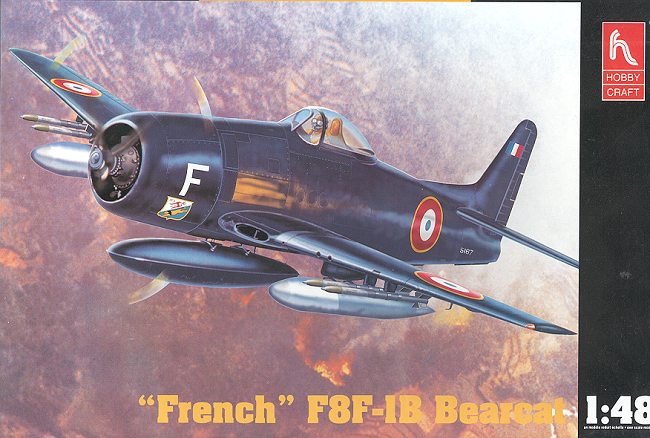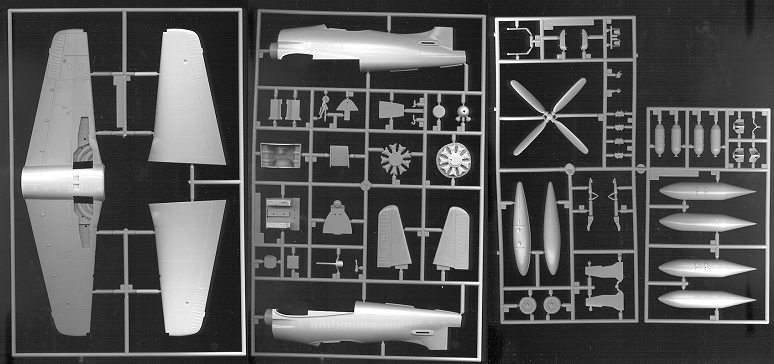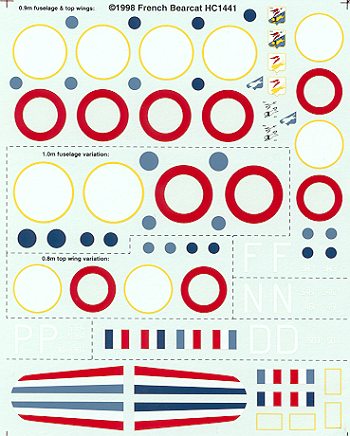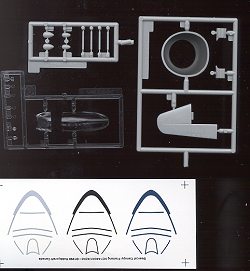
| KIT: | Hobbycraft 1/48 F8F-1B Bearcat |
| KIT # | 1441 |
| PRICE: | $16.98 |
| DECALS: | several aircraft |
| REVIEW & | |
| NOTES: |

| HISTORY |
Grumman's stubby little Bearcat was the result of putting thelargest engine into the smallest possible airframe that could accommodate allthe usual required things for use on aircraft carriers. The aircraft itself wasprobably the finest piston-engined Naval fighter to be produced, though I'm surethere are some FAA protagonists that would disagree! The aircraft was all thatthe Navy wanted and more, however, the end of the war in the Pacific meant thatthere was no real need for the aircraft and proposed construction was severelycurtailed, resulting in only 1,265 aircraft being produced between August 1944and May 1949. No Bearcats saw action on American carriers either during WW2 orduring Korea, as by that time, jets were already in place as fighters. Incivilian hands, the Bearcat proved itself to be a superb air racer, with DarrylGreenameyer's Conquest I finally beating the world speed record for propdriven aircraft in 1969, 30 years after it was last set by the Me-209v1.
It was the French who ended up taking the Bearcat into combat.As is so often the case, it was used as a ground attack platform, and not as afighter. To my knowledge, the F8F never shot down an aerial victim. France wasthe first country to receive export Bearcats in 1951; all of the 140 deliveredbeing F8F-1 and F8F-1B variants. The -1B were cannon armed. All of theseaircraft were delivered to French Indochina, where the French were having a bitof trouble with Communist insurgents.
Eventually ten squadrons were outfitted with the Bearcat and allof them served in Indochina. They were all used for ground support, though inreality there were never more than four of them on active duty at any one time.This happened during the siege of Dien Bien Phu in early 1954 during the heightof the fighting. Besides being operated as fighter bombers, a few were given toreconnaissance squadrons, where a camera pod was placed on the centerline rack.
When the French part of the Indochina war ended in mid 1954, theFrench then turned over its Bearcats to the South Vietnamese and Thai AirForces. The US also supplied Bearcats to Thailand, all of them F8F-1 and -1Bs.The -1Bs were never in operational service and were used for spares. Thailandwas the final operator of the Bearcat, striking the last one from service in1963.
| THE KIT |

Hobbycraft's kit of the Bearcat is really very nicely done. Itis pretty complete and offers everything that one would look for in a 1990smodel kit. Detail is good and enough for most modelers, with crisp engravedpanel lines and a nicely detailed interior and wheel wells. Those who havecriticized this kit have generally pointed to the engine cowling as probably thebiggest area of concern. They say that the cowling edge is too sharp and needsto be more rounded. A number of aftermarket cowlings are available for those whowish to replace this item. There are also aftermarket interiors and wheel wellsshould you wish to triple the cost of your F8F!
 Typicalof kits, there are the needed parts only to do an F8F-1B. The kit is designedfor the taller tail and different cowling of the -2, which are not included inthis kit. This version also has the additional underwing armament of napalmtanks and bombs as used by the French. They also used rockets, but despite beingshown on the box top, those are notto be found amongst the sprues. Also included is a two-piece canopy so that youcan show off the interior. I am puzzled by why some other companies still do notprovide this option as it seems like such a simple thing.
Typicalof kits, there are the needed parts only to do an F8F-1B. The kit is designedfor the taller tail and different cowling of the -2, which are not included inthis kit. This version also has the additional underwing armament of napalmtanks and bombs as used by the French. They also used rockets, but despite beingshown on the box top, those are notto be found amongst the sprues. Also included is a two-piece canopy so that youcan show off the interior. I am puzzled by why some other companies still do notprovide this option as it seems like such a simple thing.
Hobbycraft has often been derided on its instruction sheet.Basically for it being weak in calling out colors in the construction steps.This one is no exception. There is no hint as to what color landing gear struts,wheels wells, cockpit interior, or any other part of the inside of the planeshould be painted! It is only when the builder looks at some small boxes in thedecalling section that one finds information on the cockpit colors. Likemost builders and reviewers, I find this to be an incredible oversight on thepart of Hobbycraft. Sure, more experienced modelers will have a good idea ofwhat to paint these parts, but what about those who don't?
The decals provided are for four aircraft at Dien Bien Phu in1954. All of them are overall gloss sea blue, albeit that the gloss is probablygone from the planes by this time! The Hobbycraft decal sheet is just superb,offering several different roundel sizes for the builder to choose from. Thereare also two different shades of blue for these roundels as color images ofthese aircraft are quite rare. These decals are a huge improvement over earliersheets and are trulyfirst rate. I robbed a few roundels for another project and was very impressedwith the quality. Way to go, Hobbycraft!
trulyfirst rate. I robbed a few roundels for another project and was very impressedwith the quality. Way to go, Hobbycraft!
In addition to the usual markings, Hobbycraft have included asmaller decal sheet that has canopy frames on it. These are in two shades ofblue and aluminum. Many prefer to use things like this as their canopy maskingabilities are not that good. Hobbycraft should be lauded for including them aswell.
All in all, it really looks like a very nice model and one thatshould not be that difficult to build. If you want to read a full buildreview of this kit, go here.
| REFERENCES |
Grumman Aircraft since 1929 by Rene J Francillon, 1989
Review kit courtesy of me and my wallet!
If you would like your product reviewed fairly and quickly by asite that has over 1,100 visits a day, please contactme or see other details in the